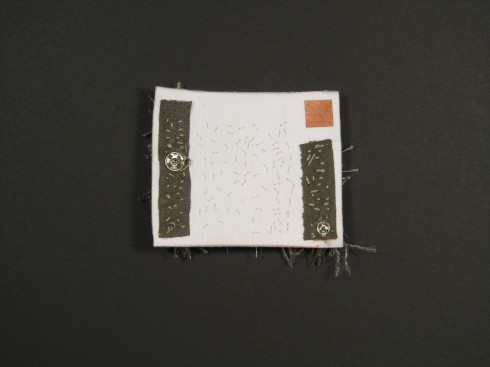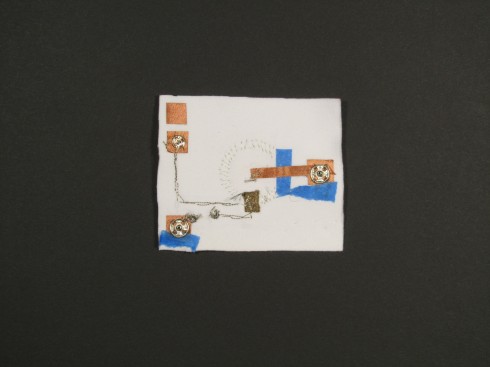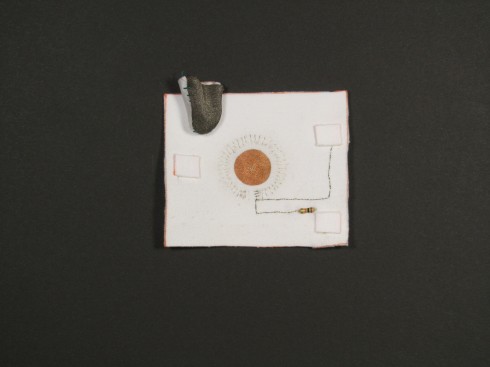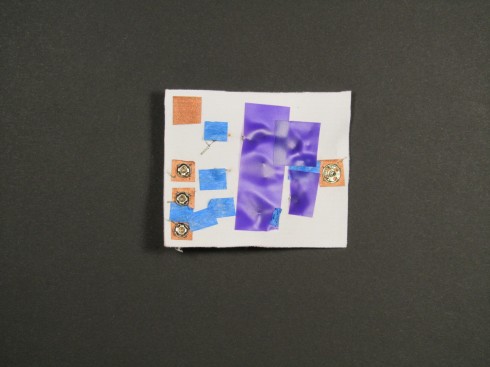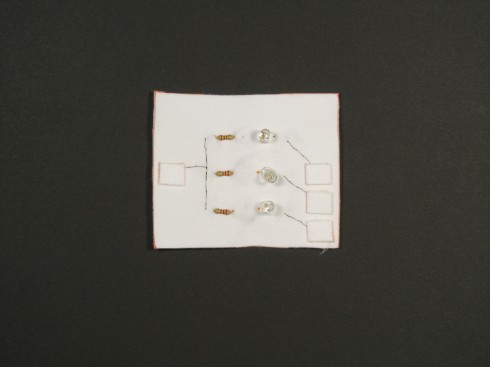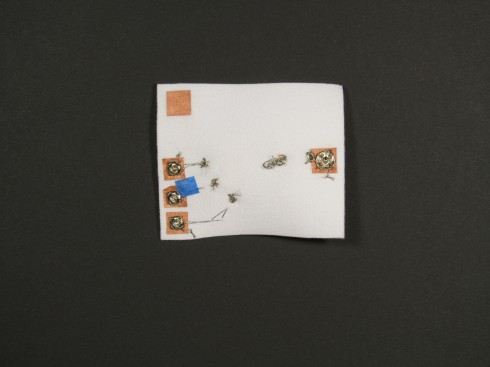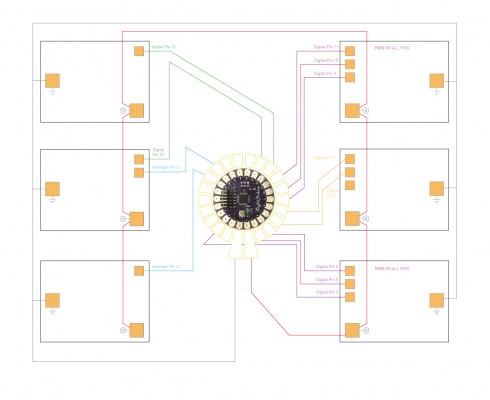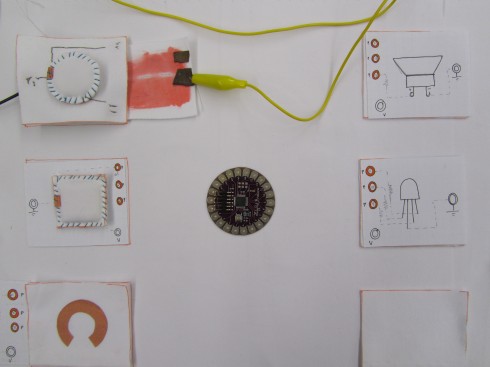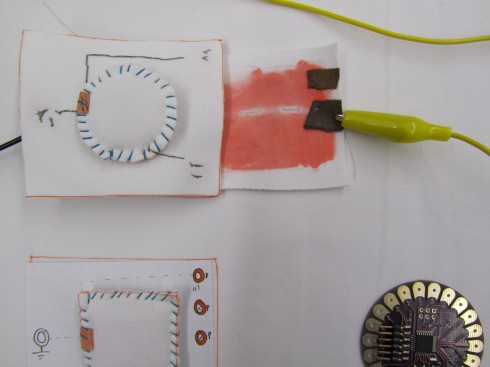SnapToTrace Final Paper
This paper is in SIGCHI format and was written for submission to the SIGCHI Conference on Tangible Embedded, Embodied Interaction 2012. You can download it here.
ABSTRACT
Modular toolkits and electronic textiles have emerged as highly effective resources to engage new audiences in computational learning. This paper will briefly review past relevant research in these domains, paying close attention to different taxonomies that consider the role of personal fabrication. Based on this analysis and user research, I will then introduce an interface prototype that is pedagogically concerned with user scalability and multiple points of entry. A specific focus is placed on the role materials play in achieving these pedagogical goals. I will close with plans for future iterations of the circuit mat and possible directions for development.
SnapToTrace Final Presentation and Feedback
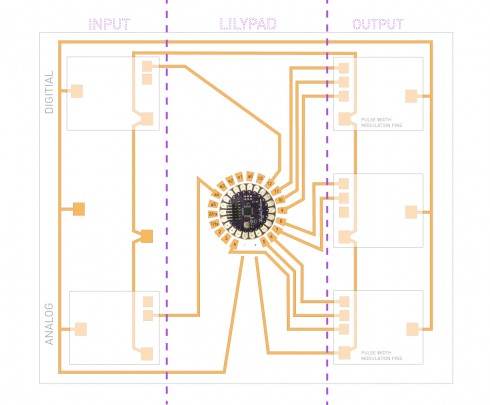
Final Presentation located here.
The feedback I received from Melanie focused mainly on developing the board as an interface to systems learning in realms outside of computation. This was fantastic feedback, especially since an early concept had framed it in this way. Katherine’s feedback was continued simplification of the components by taking them off the board. This is definitely the goal of the summer moving this project into potential thesis territory, along with some logic-based components.
SoftShop Syllabus Draft 1
Here is the link to my syllabus for a middle school program on soft circuits. It is still in an early malleability stage and its evolution will be closely tied to my major studio final project. Below is the course description:
SoftShop
Talking Lights and Stretching Sound
An Introduction to Physical Computing and SoftWear for Middle School Students
Shop Hours
Mondays from 3 – 5pm
Shop Location
2 West 13th Street, Rm 1006
Instructors
Liza Stark
TBD
Course Description and Objectives
In this course, middle school students will explore the possibilities of physical computing through soft components to offer students a large toolkit to draw from in implementing their designs. There will be a focus on interaction design, computational concepts, and craftsmanship. This course will be held largely in a workshop format with opportunities for group learning and individual work.
Learning Outcomes
By the end of this course, students will:
Major Studio Final Project Concept
Tentative Title
Does Not Compute: An Investigation into Computational Points of Entry for Middle/High School Students
Concept
For my final project, I am going to compose a curriculum aimed at introducing middle to high school students to basic electronic, programming, and design concepts through soft circuits and a create a body of compiled and personal research surrounding this sphere.
Deliverables
As of right now I am still in the process of fully flushing this out, but I will include some or all of the following:
Big Ideas
This final project is the intersection of two recent conceptual preoccupations and a recent experience at a girl’s after school session at Quest to Learn. The first preoccupation centers directly on the mystification, or demystification, of technology. The second is the idea of a point of entry, specifically regarding technology.
Background
As for the third, I have recently been interning at Quest to Learn’s Short Circuit after school program. I usually go on Thursdays when the dominant population are 6th and 7th grade boys, along with one girl who I have been working with a variety of independent projects on. Over spring break, however, I had the chance to help plan and run the Girlz Jam (I have class at this time otherwise, much to my chagrin) in which a group of ten 7th grade girls come together for a 2 hour after school session centered around a weekly topic. I should mention that the goal of this program is specifically to encourage female after school participation by creating a shared creative space, especially since at this time in development, blurry elementary school gender lines begin to focus quite sharply.
While I have had experience running after school before, this session was quite unfocused and largely dictated by the girls with the organizers acting more like herders. First and foremost, I must say that after school is hard – students have just had a long day of school and really just want to listen to music and text their friends. Secondly, teaching soft circuits is extremely difficult: it requires a rewiring of your brain around both sewing and circuitry, not an easy feat especially for those who are novices to both. In spite of this, the potential was palatable enough for me to continue thinking about it for the past five days, and brought back previous work I had done in curriculum design and interaction design in spaces of learning. For me, the design problems that arise in these areas are fascinating. Combine that with the masochistic satisfaction of working with soft circuits and e-textiles, the intersection of these domains is endlessly stimulating.
The “WHY” and Audience
Based on countless studies and statistics, bodies of research, and simple observation or questioning, computation is a realm that most of the population feels estranged from, largely due to (as I will posit for a thesis) a psychological barrier resulting from lack of exposure or disinterest in the components that they traditionally associate with programming and physical computing.
It feels trite to state the following, but its significance cannot be underscored enough: students must have more exposure to and experience with working with various technologies. This is for a variety of reasons that we have all heard before – international competition, job preparation, etc – but for this project, I will assume these as established propositions and posit that engaging youth with this type of process is innovative in its inherent ability to unlock creative potential by challenging preconceptions of materials, processes, and the cultural milieu traditionally associated with them.
Further Concepts to Incorporate
I would like this project to have an open source focus. Open source movements are in full swing and are going to play a massive role in defining culture, economics, politics – life in general – in the coming years. Following from this, as technology has become more and more accessible, a significantly large portion of the public have undergone a transformation from consumer to producer. (I would like to note, however, that these roles are not binary and there is much grey space to be exploited in between.) By making youth more aware of the individual and collective benefits of open source and the communities surrounding it, they will be more likely to actively contribute, thereby both sharing knowledge and reinforcing their own.
Autoethnography
I consider myself an academic, for better or for worse depending on time, temperament, and situation. While it isn’t a title I have always been keen to reconcile myself to, for the majority of my life I simply felt more comfortable negotiating the realm of theory – identifying historical themes, applying them to other disciplines or time periods, and speculating about what might/could have been. It is how my mind wrapped around the world. Put another way, I am fundamentally a hyper self-aware observer who finds delight in examining how others participate, acclimate, learn, and create.
In high school and college, I often found myself at a loss when having to deal with the “real” world, finding a major disconnect between academia and its application in life. When I emerged still green from undergrad, this disconnect confounded my world and largely ended up fueling my trajectory towards working in education.
I found work completely and utterly different from the school setting I was so used to: I can quite easily call up specific instances of how I had to change my behavior and how difficult that adaptation was. All of this backstory is to say that when I came to Design+Technology, I made it one of my primary goals to have a different academic experience than I had ever had before, bridging theory and practice in a proactive way that would allow me to grow the most as a designer, person, educator, participant in society – any and all of the roles that we assume during our lives.
I had many initial ideas of what the program would be and of the way I would fall into it, some ill-conceived, others right on, and the rest completely unforeseen. Coming in, I knew this would certainly not be my undergrad experience of Russian and history, and it would not be in the same mode as work. Finally retrieving a semblance of my bearings now that I am in my second semester, the following is what I have observed about how I learn here.
I. Just do it.
Concepting can be a completely harrowing experience. It can consume your life, dictate your well-being, and drive you to the edge of sanity. After a bit of winter break reflection, I came into this semester with a much better idea of what I needed to do to find and hone a concept, when to role with it and most importantly, when to drop it or transform it. Regarding yourself, it is easy to get lost in mind mire or sheer excitement. As for outside input, you are equally susceptible to falling prey to the cacophony of feedback from peers, professors, and the like. In myself and in others I have seen this happen, much to the detriment of the concept and the person. One of the things that can be difficult and that is certainly a personal trial for every student (I will make the bold assertion of “everyone”) in the program, is the multidimensional nature of the work going on around us. I.e. there is simply really cool shit going on all the time, everywhere: it requires some searching and honesty to narrow what it is you want to do. This is obviously easier for some than others, but I think everyone who has gone through this program has questioned themselves in this way at one point.
II. I am not a coder.
For as much as I want to be and for as much as I think in socio-cultural code, computation is not something I can easily wrap my head around. When working in this department, it requires patience to the point of transcendence. I must have hours to spare as well: I would say in general, one of the hardest things to balance is managing time and multi-tasking. If I am coding, I can do nothing else and I must mentally assign it at least a period of a day if not all of it.
III. I cannot work nearly as well at home as I can in the lab.
I love our lab. There is an energy that pervades the atmosphere and infuses life into the work that goes on with the community inhabiting it at any given moment. It can be distracting at times yes, but another key to DT survival is knowing when to mental break, to put something down and return to it later with fresh eyes.
IV. Drinking and smoking breaks are a must (Charlie Sheen YouTube counts as well).
As I alluded to above, no matter how much work you have, it is absolutely essential to put it down at some point then return to it. Design is mentally exhausting. Over the past semester and a half, I have strained brain muscles I didn’t know existed and come to the conclusion that more isn’t always qualitatively better. Sounds obvious, but my undergrad/work self would have none of that.
Following from this:
V. I need to do something outside school/the program/classes.
Pretty much the same as point four, except it is more to ensure a well-rounded experience, resume, and application of what I am learning. Both points are crucial to let the mind breathe in different ways to come back with a new perspective.
VI. My lack of formal training in a design realm is not a setback.
The diversity of MFADT student backgrounds is a potentially dubious feature of the program, and yet it is what makes the program so successful and dynamic. Most environments that I have been in have been fairly homogenous in makeup, leading all constituents to vie for certain roles and distinctions that create a passive aggressive or downright negative hierarchy within the group. Within the DT community this is not the case; subject “in-fighting” (e.g. p compers vs. motion graphic-ers vs. web people) is replaced by cross-disciplinary aid when a party needs it.
There is however, a palatable distinction between students who come in with a very specific technological talent or who are graphic designers or who fall outside the realm of what might be considered a “traditional” subset of the two. The “should-I-be-here” affection hits everyone at one point of the two years, and given my personal history as described above, it took me at least a semester to rid myself of the gnawing 5% that considered myself unsuitable, largely due to lack of a formal tech and design background.
VII. Prototyping = brilliant!
The concept of prototyping eluded me before entering this program. It is the best way to get something done, to begin working through an idea in a constructive way. This bullet point is actually an extension of the first: for second semester, I made a point of recognizing when a mind vortex would start as I began connecting. Once my observing ego took hold and flashed red, I took the strongest idea/iteration I had at that point and began constructing it. I saved so much unnecessary time and grief
that I took on more jobs/internships.
In conclusion, it has been a fairly crazy and tumultuously sublime process of relearning how to learn in this program. And I am sure thesis will be a game changer as well. Stay tuned.


